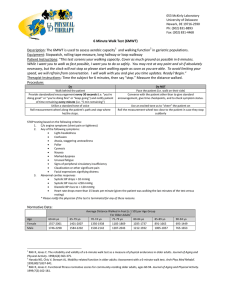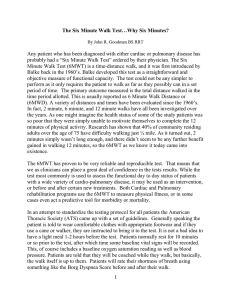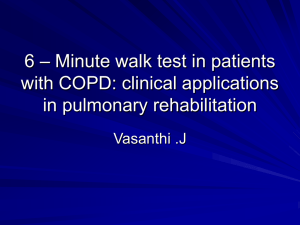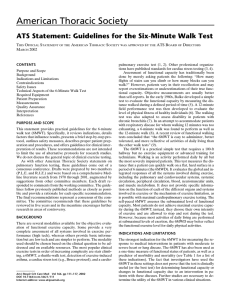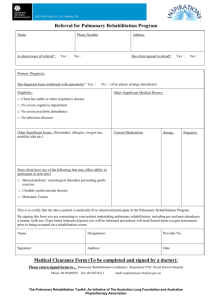The Six-Minute Walk Test
advertisement
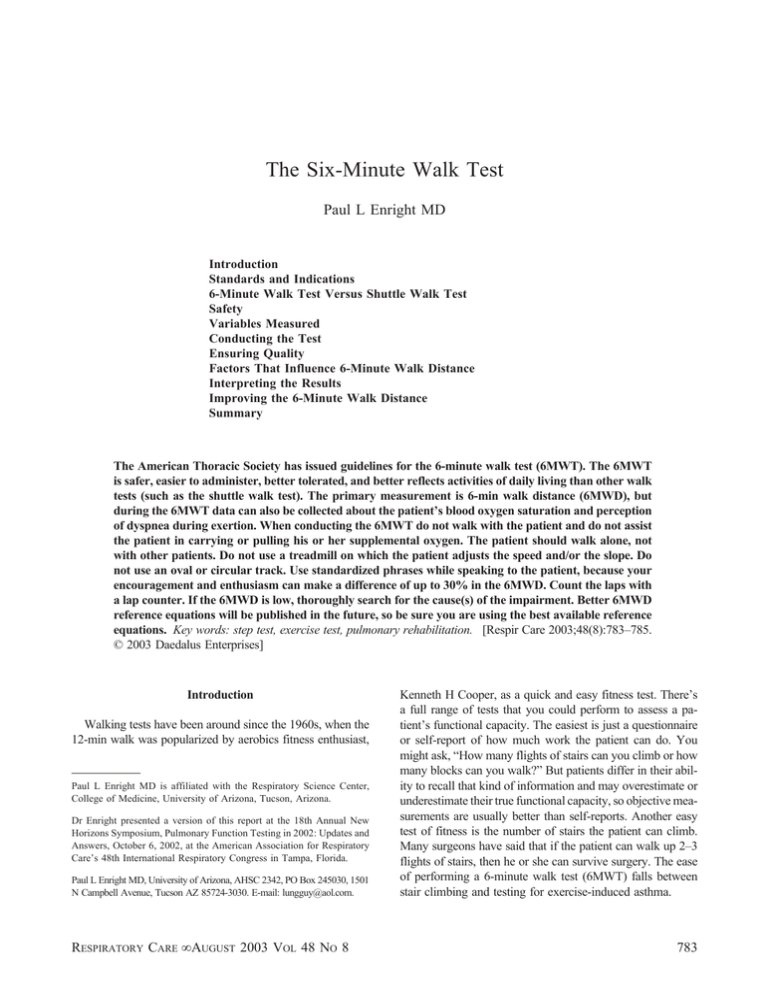
The Six-Minute Walk Test Paul L Enright MD Introduction Standards and Indications 6-Minute Walk Test Versus Shuttle Walk Test Safety Variables Measured Conducting the Test Ensuring Quality Factors That Influence 6-Minute Walk Distance Interpreting the Results Improving the 6-Minute Walk Distance Summary The American Thoracic Society has issued guidelines for the 6-minute walk test (6MWT). The 6MWT is safer, easier to administer, better tolerated, and better reflects activities of daily living than other walk tests (such as the shuttle walk test). The primary measurement is 6-min walk distance (6MWD), but during the 6MWT data can also be collected about the patient’s blood oxygen saturation and perception of dyspnea during exertion. When conducting the 6MWT do not walk with the patient and do not assist the patient in carrying or pulling his or her supplemental oxygen. The patient should walk alone, not with other patients. Do not use a treadmill on which the patient adjusts the speed and/or the slope. Do not use an oval or circular track. Use standardized phrases while speaking to the patient, because your encouragement and enthusiasm can make a difference of up to 30% in the 6MWD. Count the laps with a lap counter. If the 6MWD is low, thoroughly search for the cause(s) of the impairment. Better 6MWD reference equations will be published in the future, so be sure you are using the best available reference equations. Key words: step test, exercise test, pulmonary rehabilitation. [Respir Care 2003;48(8):783–785. © 2003 Daedalus Enterprises] Introduction Walking tests have been around since the 1960s, when the 12-min walk was popularized by aerobics fitness enthusiast, Paul L Enright MD is affiliated with the Respiratory Science Center, College of Medicine, University of Arizona, Tucson, Arizona. Dr Enright presented a version of this report at the 18th Annual New Horizons Symposium, Pulmonary Function Testing in 2002: Updates and Answers, October 6, 2002, at the American Association for Respiratory Care’s 48th International Respiratory Congress in Tampa, Florida. Paul L Enright MD, University of Arizona, AHSC 2342, PO Box 245030, 1501 N Campbell Avenue, Tucson AZ 85724-3030. E-mail: lungguy@aol.com. RESPIRATORY CARE • AUGUST 2003 VOL 48 NO 8 Kenneth H Cooper, as a quick and easy fitness test. There’s a full range of tests that you could perform to assess a patient’s functional capacity. The easiest is just a questionnaire or self-report of how much work the patient can do. You might ask, “How many flights of stairs can you climb or how many blocks can you walk?” But patients differ in their ability to recall that kind of information and may overestimate or underestimate their true functional capacity, so objective measurements are usually better than self-reports. Another easy test of fitness is the number of stairs the patient can climb. Many surgeons have said that if the patient can walk up 2–3 flights of stairs, then he or she can survive surgery. The ease of performing a 6-minute walk test (6MWT) falls between stair climbing and testing for exercise-induced asthma. 783 THE SIX-MINUTE WALK TEST Standards and Indications Recently the American Thoracic Society Pulmonary Function Standards Committee developed guidelines for the 6MWT in clinical settings.1 Carl Mottram, a respiratory therapist working at the Mayo Clinic in Rochester, Minnesota, helped to review the document. The 6MWT was chosen because it is easier to administer, better tolerated, and better reflects activities of daily living than other walk tests.2 Table 1 lists the indications for the 6MWT, the most important of which is to measure outcomes before and after treatment in people with moderate to severe heart and lung disease. The 6MWT can also be used to measure functional status and for epidemiologic purposes. A short 6-minute walk distance (6MWD) fairly accurately predicts morbidity and mortality from heart or lung disease. Table 1. Indications for the 6-Minute Walk Test Before-and-After Treatment Comparisons Lung transplantation or lung resection Lung volume reduction surgery Pulmonary rehabilitation Drug therapy for chronic obstructive pulmonary disease Pulmonary hypertension Heart failure To Measure Functional Status Chronic obstructive pulmonary disease Cystic fibrosis Heart failure Peripheral vascular disease In elderly patients To Predict Hospitalization and Death From heart failure, chronic obstructive pulmonary disease, or pulmonary hypertension 6-Minute Walk Test Versus Shuttle Walk Test How does the 6MWT compare to the shuttle walk test, which is frequently used in Great Britain? With the 6MWT the instructions to the patient are to “walk as far as you can during 6-minutes,” whereas the shuttle walk test pressures the patient to meet multiple deadlines, according to beeps from an audio cassette tape.3 The 6MWT is self-paced, and a patient is probably less likely to push himself beyond his endurance or through angina or other pain than during the shuttle walk test. The shuttle walk test is better correlated with peak oxygen uptake, as measured by a full cardiopulmonary exercise test, but not as many people are using the shuttle walk test. 784 Safety What about safety? Absolute contraindications for the 6MWT include a history of unstable angina or a heart attack during the previous month. Relative contraindications include resting tachycardia (heart rate ⬎ 120 beats/ min) or uncontrolled hypertension. Two large studies of thousands of elderly people who performed the 6MWT reported no untoward events.4,5 A physician need not be present during the test, but it is recommended that technicians administering the test be certified in cardiopulmonary resuscitation and that medications be available to treat angina, bronchospasm, and severe shortness of breath. Electrocardiographic and oxygen saturation monitoring are not necessary, and the patient should not be tethered with cables during the test. Variables Measured What variables can be measured in the 6MWT? The primary measurement is the total distance walked. Secondary measures can include fatigue and dyspnea, measured with a modified Borg or visual analog scale. Arterial oxygen saturation can also be measured via pulse oximetry, as long as the oximeter is portable and not heavy. However, I have used 3 different pulse oximeters in large epidemiologic studies during the past 10 years, and I found an unacceptably high failure rate, due to motion artifact. For the last 2 studies I chose fourth-generation pulse oximeters specifically designed to compensate for motion artifact. They are reliable for determining the oxygen saturation before and after the 6MWT test, but, in my opinion, you should be very cautious in interpreting oxygen saturation readings obtained during exercise. Conducting the Test When you schedule a walk test, ask the patient to wear comfortable footwear. During the test do not walk with the patient, because even if you walk behind them, it will alter their pace. If the patient is using supplemental oxygen during the walk, don’t help push the oxygen tank or the 6MWD will not be the same as if the patient was pushing the tank, as he or she would do at home. In one study the investigators walked 6 people at the same time, which created competition among the study participants, resulting in a 30% larger mean 6MWD than tests in which the patients walked alone.4 Ensuring Quality What should you do to obtain good quality results? Follow the recently published American Thoracic Society guidelines.1 Do not use a treadmill or bike on which the RESPIRATORY CARE • AUGUST 2003 VOL 48 NO 8 THE SIX-MINUTE WALK TEST patient adjusts the speed and/or the slope. Do not walk with the patient. Do not use an oval or circular track. You must use standardized phrases for speaking to the patient, because the amount of encouragement and enthusiasm given can make a difference of up to 30% in the 6MWD. Count the laps with a lap counter. 6MWD is low, thoroughly search for the cause(s) of the impairment. The following tests may then be helpful: pulmonary function, cardiac function, ankle-arm index, muscle strength, nutritional status, orthopedic function, and cognitive function. Improving the 6-Minute Walk Distance Factors That Influence 6-Minute Walk Distance Table 2 lists factors that influence 6MWD.5 Not surprisingly, short people and women have a shorter stride length and therefore have shorter 6MWDs. Older and heavier subjects usually have reduced muscle mass and, therefore, shorter 6MWDs, as do those who are less motivated or have impaired cognition. Arthritis and other musculoskeletal diseases also decrease the 6MWD. Table 2. Factors That Affect 6-Minute Walk Distance Factors Associated with Shorter 6-Minute Walk Distance Shorter height (shorter legs) Old age Higher body weight Female gender Impaired cognition Shorter walking corridor (more turns) Chronic obstructive pulmonary disease, asthma, cystic fibrosis, interstitial lung disease Angina, myocardial infarction, congestive heart failure, stroke, transient ischemic attack, peripheral vascular disease, ankle-arm index Arthritis; ankle, knee, or hip injuries; muscle wasting Factors Associated with Longer 6-Minute Walk Distance Taller height (longer legs) Male gender High motivation Patient has previously performed the test Medication for a disabling disease taken just before the test Oxygen supplementation Interpreting the Results Once you have measured 6MWD for a given patient, how do you interpret the result? Ideally, you would calculate the predicted distance using equations from a published study of healthy people of the same age group, much like for spirometry tests. Healthy subjects’ 6MWDs range from 400 to 700 m. However, the few published studies have all used different methods, and the predicted distances differ by up to 30% between the studies.5–7 Look for better 6MWD reference equations to be published in the future. A low 6MWD is nonspecific and nondiagnostic (just like a low maximum voluntary ventilation). If the RESPIRATORY CARE • AUGUST 2003 VOL 48 NO 8 How much will an intervention improve the 6MWD? One good study showed that an improvement of more than 70 m walked was clinically important to the patients.8 Mean improvements of 70 –170 m (12– 40% longer 6MWD) have been published for various interventions. Supplemental oxygen for chronic obstructive pulmonary disease and interstitial lung disease was shown to improve 6MWD, despite the extra weight of the ambulatory oxygen source. Lung volume reduction surgery has also been shown to improve 6MWD. In patients with chronic obstructive pulmonary disease, inhaled bronchodilators and rehabilitation programs can increase 6MWD. Summary The 6MWT is a useful measure of functional capacity, targeted at people with at least moderately severe impairment. It has been widely used for measuring the response to therapeutic interventions for pulmonary and cardiac disease. The new American Thoracic Society guidelines provide a standardized approach for performing the test. REFERENCES 1. ATS statement: guidelines for the six-minute walk test. ATS Committee on Proficiency Standards for Clinical Pulmonary Function Laboratories. Am J Respir Crit Care Med 2002;166(1):111–117. 2. Solway S, Brooks D, Lacasse Y, Thomas S. A qualitative systematic overview of the measurement properties of functional walk tests used in the cardiorespiratory domain. Chest 2001;119(1):256–270. 3. Revill SM, Morgan MDL, Singh SJ, Williams J, Hardman AE. The endurance shuttle walk: a new field test for the assessment of endurance capacity in chronic obstructive pulmonary disease. Thorax 1999;54(3):213–222. 4. Roomi J, Johnson MM, Waters K, Yohannes A, Helm A, Connolly MJ. Respiratory rehabilitation, exercise capacity and quality of life in chronic airways disease in old age. Age Ageing 1996;25(1):12–16. 5. Enright PL, McBurnie MA, Bittner V, Tracy RP, McNamara R, Arnold A, et al. The 6 minute walk test: a quick measure of functional status in elderly adults. Chest 2003;123(2):387–398. 6. Enright PL, Sherrill DL. Reference equations for the six-minute walk in healthy adults. Am J Respir Crit Care Med 1998;158(5 Pt 1): 1384–1387. 7. Gibbons WJ, Fruchter N, Sloan S, Levy RD. Reference values for a multiple repetition 6-minute walk test in healthy adults older than 20 years. J Cardiopulm Rehabil 2001;21(2):87–93. 8. Redelmeier DA, Bayoumi AM, Goldstein RS, Guyatt GH. Interpreting small differences in functional status: The Six Minute Walk test in chronic lung disease patients. Am J Respir Crit Care Med 1997; 155(4):1278–1282. 785

